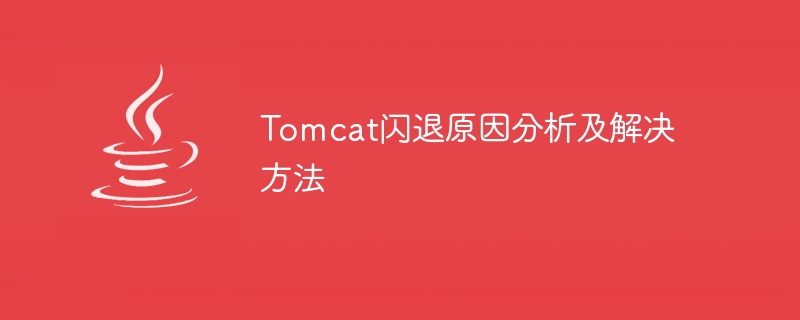

Tomcat crash causes analysis and solutions
Introduction:
With the rapid development of the Internet, more and more applications are being developed Come out and deploy on the server to provide the service. As a common Java Web server, Tomcat has been widely used in application development. However, sometimes we may encounter problems with Tomcat crashing, which will cause the application to not run properly. This article will introduce the cause analysis of Tomcat crash, provide solutions, and give specific code examples.
1. Cause analysis:
2. Solution:
(1) Increase the JVM memory limit: modify Tomcat’s catalina. bat (for Windows) or catalina.sh (for Linux) file, find the JAVA_OPTS parameter in the file, and add parameters such as -Xmx and -XX:MaxPermSize to increase the memory limit. For example:
set "JAVA_OPTS=%JAVA_OPTS% -Xmx1024m -Xms512m -XX:MaxPermSize=512m"
(2) Fix memory leaks: Use Java memory analysis tools (such as Eclipse Memory Analyzer) To detect and locate memory leaks and repair the code. For example, for the problem that the database connection is not closed correctly, you can add code to close the connection in the appropriate place. The following is a simple code example:
public void closeConnection(Connection conn) {
try {
conn.close();
} catch (SQLException e) {
e.printStackTrace();
}
}Use a thread detection tool (such as VisualVM) to detect the thread deadlock problem and analyze it Thread resource contention situation. Use the synchronized keyword in your code to synchronize access to shared resources and ensure the correct resource release order to avoid thread deadlock. The following is a simple code example:
public void method1() {
synchronized (resource1) {
// do something
synchronized (resource2) {
// do something
}
}
}
public void method2() {
synchronized (resource2) {
// do something
synchronized (resource1) {
// do something
}
}
}Check the third-party library used in the application and the Tomcat preset library versions and make sure they are compatible. If there are incompatibility issues, you can specify a specific version of the library in your project's pom.xml file (if using Maven) or build.gradle file (if using Gradle). For example, when using Maven:
<dependencies>
<dependency>
<groupId>com.example</groupId>
<artifactId>example-library</artifactId>
<version>1.0.0</version>
</dependency>
...
</dependencies>Conclusion:
Tomcat crash problem is one of the common problems in application development. When facing Tomcat crash, we should carefully analyze the cause and take corresponding solutions. This article introduces common causes of Tomcat crashes such as memory overflow, thread deadlock, and third-party library conflicts, and provides solutions and specific code examples. I hope these contents can help readers better understand and solve the problem of Tomcat crash.
The above is the detailed content of Analyze and solve the reasons why Tomcat crashes. For more information, please follow other related articles on the PHP Chinese website!
 What are the four big data analysis tools?
What are the four big data analysis tools?
 statistical analysis
statistical analysis
 How to configure Tomcat environment variables
How to configure Tomcat environment variables
 How to integrate idea with Tomcat
How to integrate idea with Tomcat
 How to view Tomcat source code
How to view Tomcat source code
 What are the common tomcat vulnerabilities?
What are the common tomcat vulnerabilities?
 How to solve garbled tomcat logs
How to solve garbled tomcat logs
 What are the differences between weblogic and tomcat
What are the differences between weblogic and tomcat




